Preston, Lancashire
Preston /ˈprɛstən/ (![]()
| Preston | |
|---|---|
| City | |
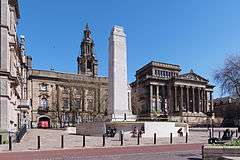 Preston Flag Market, including Sessions House, the Cenotaph and Harris Museum | |
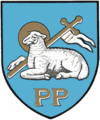 Arms of the City Council | |
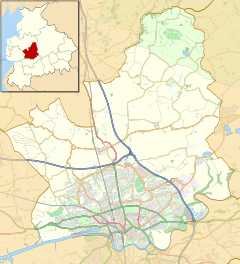 Preston Shown within the City of Preston district 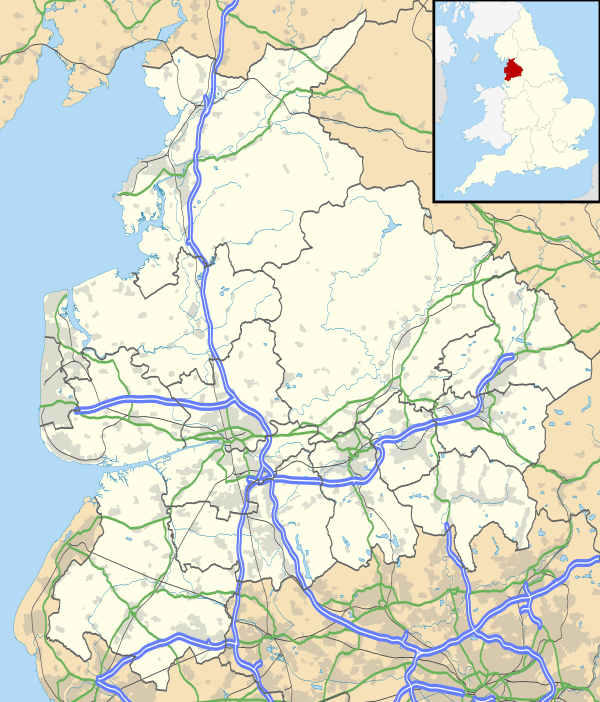 Preston Location within Lancashire | |
| Population | 122,719 (Including Fulwood, which makes up the whole unparished area, 2011) |
| Demonym | Prestonian |
| District |
|
| Shire county | |
| Region | |
| Country | England |
| Sovereign state | United Kingdom |
| Post town | PRESTON |
| Postcode district | PR1-PR2 |
| Dialling code | 01772 |
| Police | Lancashire |
| Fire | Lancashire |
| Ambulance | North West |
| UK Parliament |
|
Preston and its surrounding area have provided evidence of ancient Roman activity, largely in the form of a Roman road which led to a camp at Walton-le-Dale. The Angles established Preston; its name is derived from the Old English meaning "priest's settlement" and in the Domesday Book is recorded as "Prestune". In the Middle Ages, Preston was a parish and township in the hundred of Amounderness and was granted a Guild Merchant charter in 1179, giving it the status of a market town. Textiles have been produced since the mid-13th century when locally produced wool was woven in people's houses. Flemish weavers who settled in the area in the 14th century helped develop the industry. In the early-18th century, Edmund Calamy described Preston as "a pretty town with an abundance of gentry in it, commonly called Proud Preston".[5] Sir Richard Arkwright, inventor of the spinning frame, was born in the town. The most rapid period of growth and development coincided with the industrialisation and expansion of textile manufacturing. Preston was a boomtown of the Industrial Revolution, becoming a densely populated engineering centre, with large industrial plants. The town's textile sector fell into terminal decline from the mid-20th century and Preston has subsequently faced similar challenges to other post-industrial northern towns, including deindustrialisation, economic deprivation and housing issues.
Preston is the seat of Lancashire County Council, houses the main campus of the University of Central Lancashire (UCLan) and is home to Preston North End F.C., a founder member of the Football League and the first English football champions.
Etymology
Preston is recorded in the Domesday Book as "Prestune" in 1086.[6] Various other spellings occur in early documents: "Prestonam" (1094), "Prestone" (1160), "Prestona" (1160), "Presteton" (1180), and "Prestun" (1226). The modern spelling occurs in 1094, 1176, 1196, 1212 and 1332.[7] The town's name is derived from Old English Presta and Tun, the Tun (enclosure, farmstead, village, manor, estate)[8] of the Presta (priest or priests).[9]
History
Early development
During the Roman period, Roman roads passed close to what is now the centre of Preston. For example, the road from Luguvalium to Mamucium (now Carlisle to Manchester) crossed the River Ribble at Walton-le-Dale, 3⁄4 mile (1 km) southeast of the centre of Preston, and a Roman camp or station may also have been here.[10][11] At Withy Trees, 1 1⁄2 miles (2 km) north of Preston, the road crossed another Roman road from Bremetennacum (the Roman fort at Ribchester) to the coast.[12]
An explanation of the origin of the name is that the Priest's Town refers to a priory set up by St Wilfrid near the Ribble's lowest ford. This idea is supported by the similarity of the Paschal lamb on Preston's crest with that on St Wilfrid's.[13]
When first mentioned in the 1086 Domesday Book, Preston was already the most important town in Amounderness (the area of Central Lancashire between the rivers Ribble and Cocker, including The Fylde and the Forest of Bowland). When assessed for tax purposes in 1218 – 19 it was the wealthiest town in the whole county.[14]
Guild Merchant

The right to hold a Guild Merchant was conferred by King Henry II upon the burgesses of Preston in a charter of 1179; the associated Preston Guild is a civic celebration held every 20 years and 2012 was the latest guild year. It is the only guild still celebrated in the UK.[15]
Before 1328, celebrations were held at irregular intervals, but at the guild of that year it was decreed that subsequent guilds should be held every 20 years. After this, there were breaks in the pattern for various reasons, but an unbroken series were held from 1542 to 1922. A full 400-year sequence was frustrated by the cancellation of the 1942 guild due to World War II, but the cycle resumed in 1952. The expression '(Once) every Preston Guild', meaning 'very infrequently', has passed into fairly common use, especially in Lancashire.
Guild week is always started by the opening of the Guild Court, which since the 16th century has traditionally been on the first Monday after the feast of the Beheading of John the Baptist celebrated on 29 August. As well as concerts and other exhibitions, the main events are a series of processions through the city. Numerous street parties are held in the locality.
In 1952 the emphasis was on the bright new world emerging after the war. The major event, held in the city's Avenham Park, had every school participating, and hundreds of children, from toddlers to teenagers, demonstrated different aspects of physical education in the natural amphitheatre of the park.
In 1972 participants at the Avenham Park celebrations were treated to a low level, low speed, flypast by Concorde.
The 2012 guild formally opened on 2 September with a mayoral proclamation and the return of "friendship scrolls" that had travelled the world.[16] Highlights in the programme for the 2012 celebration included two concerts in Avenham Park - one by Human League and another, a "Proms In The Park", featuring José Carreras, Katherine Jenkins and the Manchester Camerata.
Pre-industrial Preston
_Dunn_and_first_gas-lit_building.jpg)
In the mid-12th century, Preston was in the hundred of Amounderness, in the deanery of Amounderness and the archdeaconry of Richmond. The name "Amounderness" is more ancient than the name of any other "Wapentake" or hundred in the County of Lancashire, and the fort at Tulketh, strengthened by William the Conqueror, shows that the strategic importance of the area was appreciated even then.[17]
The location of the city, almost exactly midway between Glasgow and London, led to many decisive battles being fought here, most notably during the English Civil War at the Battle of Preston (1648), and then the first Jacobite rebellion, whose invasion of England was brought to a conclusion by the defeat of the pro-Catholic and pro-monarchial Jacobite army at the Battle of Preston (1715). Letitia Elizabeth Landon alludes to this latter defeat in her poem Preston in Fisher's Drawing Room Scrap Book 1834.
| Wikisource has original text related to this article: |
_p2.090_-_Map_of_Preston_as_it_was_in_1774.jpg)
In the last great Jacobite Rising, on 27 November 1745 the Jacobite Prince of Wales and Regent, Bonnie Prince Charlie passed through Preston with his Highland Army on the way south through Chorley and Manchester to Derby intending to take London and the Crown. Preston was the first of quite a few places in England where the Prince was cheered as he rode by and where he was joined by some English volunteers for his Army. One Jacobite eyewitness noted that from Preston onwards, "at every town we were received with ringing of bells, and at night we have bonfires, and illuminations".[18] Another Jacobite eyewitness noted in a private letter from Preston on 27 November 1745: "People here are beginning to join [us] very fast; we have got about sixty recruits today".[19] From 10 to 12 December the Prince gave his retreating Army a rest in Preston on their long, last and fatal retreat from Derby through Lancaster and Carlisle to their dreadful day of destiny the following 16 April on Culloden Moor near Inverness.[20]
Industrial revolution
The 19th century saw a transformation in Preston from a small market town to a much larger industrial one, as the innovations of the latter half of the previous century such as Richard Arkwright's water frame (invented in Preston) brought cotton mills to many northern English towns. With industrialisation came examples of both oppression and enlightenment.
The town's forward-looking spirit is typified by it being the first English town outside London to be lit by gas. The Preston Gas Company was established in 1815 by, amongst others, a Catholic priest: Rev. Joseph "Daddy" Dunn of the Society of Jesus. The Preston and Wigan Railway arrived in 1838, shortly afterwards renamed the North Union Railway.[21] The Sheffield firm of Thos W Ward Ltd opened a ship breaking yard at Preston Dock in 1894.[22]
The more oppressive side of industrialisation was seen during the Preston Strike of 1842 on Saturday 13 August 1842, when a group of cotton workers demonstrated against the poor conditions in the town's mills. The Riot Act was read and armed troops corralled the demonstrators in front of the Corn Exchange on Lune Street. Shots were fired and four of the demonstrators were killed. A commemorative sculpture now stands on the spot (although the soldiers and demonstrators represented are facing the wrong way). In the 1850s, Karl Marx visited Preston and later described the town as "the next St Petersburg".[23] Charles Dickens visited Preston in January 1854 during a strike by cotton workers that had by that stage lasted for 23 weeks. This was part of his research for the novel Hard Times in which the town of "Coketown" is based on the city of Preston. In 1858, the Preston Power Loom Weavers' Association was founded, and by 1920 it had more than 13,000 members in the town.[24]
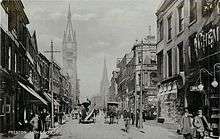
The Preston Temperance Society, led by Joseph Livesey pioneered the Temperance Movement in the 19th century. Indeed, the term teetotalism is believed to have been coined at one of its meetings. The website of the University of Central Lancashire library has a great deal of information on Joseph Livesey and the Temperance Movement in Preston.[25]
Preston was one of only a few industrial towns in Lancashire to have a functioning corporation (local council) in 1835 (its charter dating to 1685), and was reformed as a municipal borough by the Municipal Corporations Act 1835. It became the County Borough of Preston under the Local Government Act 1888. In 1974, county boroughs were abolished, and it became part of the larger part of the new non-metropolitan district, the Borough of Preston, which also included Fulwood Urban District and much of Preston Rural District. The borough acquired city status in 2002.
Preston since the early 20th Century
By 1901, nearly 120,000 people were living in Preston, now a booming industrial town.
New industries arrived in Preston during the interwar years which helped ease the pain felt through the sharp decline of the cotton industry. Electrical goods manufacturing and engineering arrived in the town, and the building sector enjoyed a boom with nearly 3,000 council houses being built between 1920 and 1939. Some 1,500 houses were built for private sale.
Despite its heavy industry, Preston endured only a handful of Luftwaffe air raids in World War II and there were no fatalities in the town, although an air crash in the Freckleton district claimed the lives of 61 people in 1944.
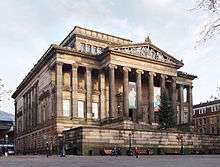
For some 20 years after 1948, Preston became home to a significant number of Asian and Caribbean Commonwealth immigrants, who mostly worked in the manufacturing industry. However, an economic decline hit the town once again in the 1970s, capped by the closure of the Courtaulds factory in 1979 (nearly 3,000 job losses) and the decline of the docks on the River Ribble, which finally closed in 1981. Mass unemployment was firmly back in Preston by the early 1980s, although it was now very much a national crisis due to the recession of that time.
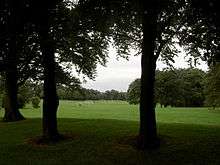
The rehousing of families from town centre slums to new council houses continued after World War II, though it slowed down to a virtual standstill after 1975. The face of the town centre began to change in the 1960s, with old developments being bulldozed and replaced by modern developments such as the St George's Shopping Centre, which opened in 1966, and the Fishergate Shopping Centre which was built nearly 20 years later. The remains of the Victorian town hall, designed by George Gilbert Scott and mostly destroyed by fire in 1947, were replaced by an office block (Crystal House) in 1962, and a modern-architecture Guild Hall opened in 1972, to replace the Public Hall.
The town was by-passed by Britain's very first motorway which opened in 1958 and within a decade formed part of the M6 – giving Preston a direct motorway link with Manchester and Birmingham. The late 1960s saw the completion of Ringway, a bypass around the town centre, as well as a new bus station.[26]
On 6 April 2012 the city's residents performed the Preston Passion, a dramatised version of the Passion of Christ, which was broadcast live by BBC One.[27]
Governance
The unparished urban settlement of Preston is represented by 19 of the 22 council wards within Preston City Council. Preston is currently divided between two Westminster constituencies, namely Preston and Wyre and Preston North. The County Hall is located on Fishergate and is the main office for Lancashire County Council.[28] Preston Council Buildings are found on Lancaster Road.
Geography
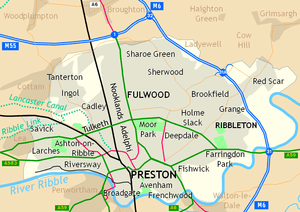
The River Ribble provides a southern border for the city. The Forest of Bowland forms a backdrop to Preston to the northeast while the Fylde lies to the west. At 53°45′N 2°42′W, Preston is approximately 27 miles (43 km) north west of Manchester, 26 miles (42 km) north east of Liverpool, and 15 miles (24 km) east of the coastal town Blackpool.
The current borders came into effect on 1 April 1974, when the Local Government Act 1972 merged the existing County Borough of Preston with Fulwood Urban District as an unparished area within the Borough of Preston. Preston was designated as part of the Central Lancashire new town in 1970.
Climate
The climate of Preston is of a temperate maritime type, with a narrow range of temperatures, similar to the rest of the British Isles. Being relatively close to the Irish sea, this is more pronounced than areas to the south and east of Preston. The official Met Office weather station is located at Moor Park, less than 1 mile (1.6 km) north of the city centre, and surrounded by built up areas, suggesting a degree of urban warming is likely, particularly during clear and calm nights.
The absolute high recorded at the weather station was 33.1 °C (91.6 °F)[29] during August 1990. In a typical year the warmest day should reach 27.6 °C (81.7 °F)[30] and 5.9 days[31] in total should attain a maximum temperature of 25.1 °C (77.2 °F) or more. In October 2011, a new record October high temperature of 26.9 °C was set.[32]
The absolute minimum is −13.3 °C (8.1 °F), recorded during February 1969.[33] In a typical year the coldest night should fall to −6.8 °C (19.8 °F),[34] and 40.2 nights[35] should receive an air frost. The lowest temperature in recent years was −9.2 °C (15.4 °F)[36] during December 2010.
Annual rainfall totals just under 1000 mm per year,[37] with over 1 mm of precipitation falling on 150 days.[38] All averages refer to the period 1971–2000.
In October 2014 Preston was officially ranked "the wettest city in England", and third wettest in the UK behind Cardiff and Glasgow.[39] It was also ranked "the gloomiest city in England", as it gets fewer hours of sunshine in a year than any other English city or town.[40] However, in March 2018 the Lancashire Evening Post reported that Preston has lost its "soggy city status" to the neighbouring town of Lancaster.[41]
| Climate data for Preston Moor Park, elevation 33 m, 1971–2000, extremes 1960–2005 | |||||||||||||
|---|---|---|---|---|---|---|---|---|---|---|---|---|---|
| Month | Jan | Feb | Mar | Apr | May | Jun | Jul | Aug | Sep | Oct | Nov | Dec | Year |
| Record high °C (°F) | 14.1 (57.4) |
16.2 (61.2) |
22.2 (72.0) |
24.0 (75.2) |
27.3 (81.1) |
30.6 (87.1) |
31.0 (87.8) |
33.1 (91.6) |
26.8 (80.2) |
23.6 (74.5) |
18.4 (65.1) |
15.6 (60.1) |
33.1 (91.6) |
| Average high °C (°F) | 6.9 (44.4) |
7.3 (45.1) |
9.4 (48.9) |
12.0 (53.6) |
15.6 (60.1) |
17.7 (63.9) |
19.8 (67.6) |
19.5 (67.1) |
16.8 (62.2) |
13.4 (56.1) |
9.7 (49.5) |
7.7 (45.9) |
13.0 (55.4) |
| Average low °C (°F) | 1.7 (35.1) |
1.9 (35.4) |
3.1 (37.6) |
4.5 (40.1) |
7.1 (44.8) |
10.0 (50.0) |
12.2 (54.0) |
12.1 (53.8) |
9.9 (49.8) |
7.3 (45.1) |
4.0 (39.2) |
2.4 (36.3) |
6.4 (43.5) |
| Record low °C (°F) | −11.1 (12.0) |
−13.3 (8.1) |
−9.4 (15.1) |
−4.5 (23.9) |
−2.3 (27.9) |
0.6 (33.1) |
4.4 (39.9) |
2.8 (37.0) |
−0.5 (31.1) |
−5.2 (22.6) |
−6.7 (19.9) |
−12.8 (9.0) |
−13.3 (8.1) |
| Average precipitation mm (inches) | 93.83 (3.69) |
63.66 (2.51) |
79.11 (3.11) |
52.08 (2.05) |
58.79 (2.31) |
73.51 (2.89) |
65.40 (2.57) |
86.51 (3.41) |
92.00 (3.62) |
113.78 (4.48) |
103.86 (4.09) |
112.02 (4.41) |
997.99 (39.29) |
| Average snowy days | 2 | 2 | 1 | 1 | 0 | 0 | 0 | 0 | 0 | 0 | 1 | 2 | 9 |
| Source: KNMI[42] | |||||||||||||
Demographics
Religion


Preston has a strong Roman Catholic Christian history and tradition, recently noted by Archbishop Vincent Nichols in his Guild 2012 Mass Homily: "The history of the Christian and Catholic faith is long and deep here in Preston." [43] with one of the proposed derivations of its name coming from 'Priests town'. The lamb on the city shield is a biblical image of Jesus Christ, and the same image that represented 7th century bishop St Wilfrid, the city's patron saint who is historically linked to the city's establishment. The "PP" on the city shield stands for "Princeps Pacis" (Prince of Peace), another title for Christ invoking Him as protector of the city, though it is also often taken to stand for the city's nickname "Proud Preston". In fact there were originally three letters "P" on the coat of arms, with one being lost over time.[44]
Preston lies in the Roman Catholic Diocese of Lancaster and the Anglican Diocese of Blackburn. There are at least 73 churches, chapels, missions and meeting houses, as well as 15 cemeteries and burial sites, for which records exist.[45] A wide range of denominations are, or have been, represented in the city including: Latin Rite Catholics, Baptist, Christadelphian, Congregational, Countess of Huntingdon's Connexion, Evangelical, Methodist, Pentecostal, Presbyterian, Swedenborgian and Wesleyan Methodist. The Society of Friends meet at the Preston Friends Meeting House at 189 St George's Road.[46]
In July 2016, St Ignatius Church in Preston, which had been gifted by the Catholic Diocese of Lancaster to the Syro-Malabar Catholic community, was raised to the status of a Cathedral by Pope Francis. It now serves as the seat of the Syro-Malabar Catholic Eparchy of Great Britain [47][48]
Built in 1826 for the Calvinistic Methodists of Lady Huntington, the Carey Baptist church, on Pole Street, was formerly known as St Paul's Chapel. It was purchased by the Baptists in 1855. The church survives today and remains very active in the community.[49]
St. John's Minster, formerly the Church of St John the Evangelist and prior to the reformation; St Wilfrid's Parish Church, is located on Church Street, in the centre of the city. From its origin it has been the parish church of Preston. The church of St George the Martyr, located on Georges Road, was founded in 1723.[50] One of the many large active Roman Catholic parish churches is St Thomas of Canterbury and the English Martyrs, located on Garstang Road.[51]
Preston was the location of the world's first foreign mission of the Church of Jesus Christ of Latter Day Saints (commonly known as the Mormons). As early as 1837 the first Mormon missionaries to Great Britain began preaching in Preston and, in particular, other small towns situated along the River Ribble. Preston is home to the world's oldest continuous branch (a small congregation) of the LDS Church.[52] An official memorial to the church pioneers may be found in the Japanese Garden in Avenham Park. In 1998 the LDS erected a large temple at Chorley, near Preston, described by The Telegraph newspaper as "spectacular".[53] The temple is officially known as the Preston England Temple.
Preston has a significant Muslim (Sunni Branch, particularly Hanafi school) population, the majority of which is of Gujarati Indian descent. The Muslim population is centred in the Deepdale, Riversway, Fishwick, Fulwood and Frenchwood areas. Preston has 12 mosques: five in Deepdale & St George's, one in Frenchwood, one in Riversway, two in Adelphi and three in Fishwick.
The 2001 Census recorded 72% of the population of the City of Preston as Christians, 10% as having no religion, and 8% as Muslims.[54] The Hindu and Sikh populations are smaller at 3% and 0.6% respectively, but in both cases this represents the highest percentage of any local authority area in the North West. 2% of the city's population were born in other EU countries. Though still small in number in Preston, the Mormons maintain a large profile.
Preston has places of worship for people of a wide variety of religions, including churches of many Christian denominations. There are also places of worship for Buddhists, Hindus, Muslims, the Jehovah's Witnesses, Mormons, Sikhs and The Salvation Army, amongst others. Preston was also home to an Ashkenazi Orthodox Jewish synagogue on Avenham Place, formed in 1882, but this closed during the mid-1980s.[55]
The demonym for residents of the city is "Prestonian", and the centre of the city is referred to by residents colloquially as "The Gate".[56][57]
Landmarks
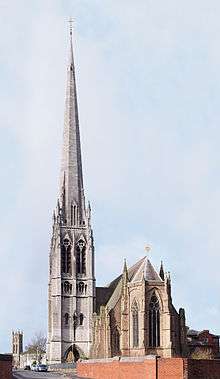
St Walburge's Church, designed by Joseph Hansom of Hansom Cab fame, has, at 94 metres (308 ft), the tallest spire in England on a church that is not a cathedral.[58] There are also many notable buildings dotted in and around the city centre including the Miller Arcade, the Town Hall, the Harris Museum, the Minster Church of St. John the Evangelist (formerly Preston Parish Church, elevated to Minster church status in June 2003), the former Corn Exchange and Public Hall, St. Wilfrid's Catholic Church, Fishergate Baptist Church, and many beautiful Georgian buildings on Winckley Square. Many Catholic and Anglican parish churches are also to be found throughout the city. HMP Preston is also a good example of a typical Victorian radial-design prison. Modern architecture is represented by the Guild Hall and Preston Bus Station, which was featured on the 2012 World Monument Fund's list of sites at risk due to threats of demolition,[59][60] before becoming Grade II listed.
| Museums | Parks | Nature reserves |
|---|---|---|
|
|
|
Listed buildings
| Grade I | Grade II* | Grade II | |
|---|---|---|---|
|
|
|
and hundreds more[61] |
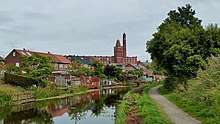
The chimney of the Grade II listed Tulketh Mill, recently fully exposed on the Blackpool Road, provides an impressive reminder of Preston's industrial heritage. The mill itself, designed by engineer Fred Dixon of Bolton for the Tulketh Spinning Company, dates from 1905.[62] The huge chimney has been lowered twice – in the 1930s and again in the 1960s.
Monuments and public artworks
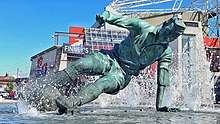
Preston has a number of notable monuments and public artworks, including:
- Obelisk: located opposite the Cenotaph on Preston's Market Square, the Obelisk dates back to 1782 and was originally installed for the Guild celebration of the same year.[63]
- Peace Gardens: located on Friargate, the gardens, designed by Graham Mort, originally housed the praying hands sculpture which now resides on Fylde Road.[64]
- Preston Martyrs' Memorial: located in front of the Corn Exchange in Lune Street, this sculpture marks the site of the Lune Street Riots which occurred during the 1842 General Strike, when troops opened fire on striking mills workers, killing four and injuring three.[65]
- "The Splash": a sculpture of Sir Tom Finny, located in front of the Deepdale football stadium. The statue is based upon a famous photo taken of Finney in a game against Chelsea in 1956, which was named England's Sports Photograph of the Year.[66]
Economy
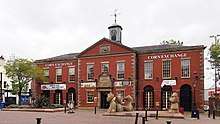
Preston has seen many changes over the course of its history in regards to its local economy, shifting from a market town to the textile industry and more recently to tertiary education and research.
The city was home to Alstom Transport's main UK spare parts distribution centre (formerly GEC Traction Ltd) until it transferred operations to Widnes in July 2018.[67] Matalan Retail Ltd was also founded in Preston under the name Matalan Cash and Carry. Although the head office of Matalan moved to Skelmersdale in 1998, the city still has the tax office for the company (located in Winckley Square).
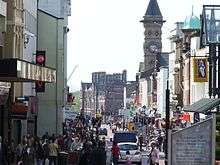
Goss Graphic Systems Limited, a global supplier of printing presses based in the United States, formerly employed more than 1,000 people in Preston, but in 2007 the company moved manufacturing to the United States, China and Japan and now has around 160 employees in the city.[68]
Unemployment in Preston rose 15% in the year up to April 2012 to a total of 3,783 claimants.[69] However, in November 2018 Preston was named as "Most improved city in UK", with unemployment down to 3.1% from 6.5% in 2014, and improvements above the national average for health, transport, the work-life balance of its residents, and for the skills among both the youth and adult populations.[70]
Major employers
Preston is a major centre of the British defence aerospace industry with BAE Systems, the UK's principal military aircraft design, development and manufacture supplier, having its Military Aircraft headquarters located in nearby Warton. The company has two of its major facilities located some miles on either side of the city. BAE Warton is located to the western side of the city whilst BAE Samlesbury is located to the east, over the M6 motorway. BAE Systems also operate large office facilities at the Portway area within the city and at The Strand office complex.
On 20 February 2006, the telecommunications company The Carphone Warehouse took over Tulketh Mill (formerly the home of the Littlewoods catalogue call centre) in the Ashton-on-Ribble area of the city. The building has undergone an extensive interior refurbishment and since March 2007 has been the workplace of some 800 employees. The site's main purpose is as a call centre for the broadband and landline services provider TalkTalk as well as The Post Office and Student Loans Company. The site also houses call centres for Team Knowhow and Carphone Warehouse which are now part of Dixons Carphone. It was officially opened on 19 December 2006 by CEO Charles Dunstone and the Mayor of Preston.
Due to Preston's location as a transport hub, sitting between the M6, M55, M65, and M61 it is home to several freight and haulage companies. Haulage supplier and operator James Hall and Co who supply produce for Spar stores in the north of England have their head office - the biggest building in the city of Preston[71] - located just off the M6 Junction 31a at Bowland View.
The Riversway area (in the Ashton-on-Ribble area of the city) is also home to the Preston Docklands, once Europe's largest single dock basin, which has undergone redevelopment. Several office areas around the docks, along with significant residential presence. Several small businesses such as the Football League's LFE headquarters[72] are based in the area, together with Riversway Developments[73] who have been responsible for some of this redevelopment.
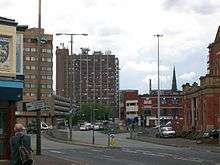
The financial sector also has a presence in the city with a large selection of consultancies, insurance and law firms based in Winckley Square in the city centre.
The Westinghouse Electric Company (formerly BNFL) Springfields nuclear processing plant also lies to the west of the city boundary at Salwick.
Skiddle is an event ticketing operation based in Preston since 2001, which claims to be the UK's largest what's on guide.
Retail
Retail is also a major contributor to Preston's economy. The city's main high streets are Fishergate and Friargate which offer shops, bars and restaurants with many more tucked away down the side streets. Two major shopping centres are located along the high streets:
- Fishergate Shopping Centre – which has a Debenhams department store, McDonald's, Poundland, Starbucks, Evans (clothing), Lush, Sports Direct, TK Maxx and Argos stores.
- St George's Shopping Centre (formerly The Mall Preston) – a popular centrally located shopping mall dating from the 1960s.
Preston is also home to the historic Covered Market and Fishmarket. In 2016 these sites were redeveloped and the old covered market now contains the new Market Hall and Outdoor and Secondhand Markets, and the old fish market now contains the Box Market, a unique shopping space consisting of upgraded shipping containers. Market vendors sell fresh and local quality meat, fish, fruit, vegetables, and dairy products, hot and cold food to eat in or take away, as well as brewed ales and artisan coffee. The markets are open Monday-Saturday and on Tuesdays, a Car boot sale operates from the Outdoor Market [74]
Also in the city centre is the Miller Arcade, a specialist shopping centre in a listed building (which formerly included public baths), is situated off Fishergate near the Harris Museum.
The first Kentucky Fried Chicken (KFC) outlet in the UK was opened on Fishergate in 1965.[75]
A number of large retail shopping centres can be found in Preston's suburbs and surrounding towns, including:
- Capitol Centre Retail Park on the A6 London Road to the south of the city at Walton-le-Dale. The centre has over 20 major stores including Boots, Carphone Warehouse, Curry's-PC World, Gap Outlet, Next and TK Maxx, and various fast-food restaurants including McDonalds, Starbucks and Subway. There is also a Vue Cinema, and Tesco and Waitrose supermarkets. Free car parking is provided along with a bus interchange.[76]
- Deepdale Shopping park, on the A5085 Blackpool Road on the northern edge of the city, has over 30 major stores including Boots, Carphone Warehouse, Halfords, Marks & Spencer, Next and Wilko, and various fast-food restaurants including KFC, McDonalds and Pizza Hut. There is also an Aldi supermarket, as well as a Morrisons nearby. Free parking is provided for over 1,000 cars.[77]
- Riversway Retail Park, located off the A583 Riversway at Ashton-on-Ribble. Stores include home furnishings providers Bensons For Beds, DFS and ScS Sofa Carpet Specialist. Other retailers include Halfords and Pets At Home, and there is a Morrisons Supermarket, Homebase DIY and a McDonalds fast-food restaurant. Nearby is an Odeaon cinema, KFC and a Chiquito restaurant. Free parking is provided.[78]
- South Rings Business Park, located off the A6 at Bamber Bridge, near the intersection of the M6, M65 and M61 motorways. There are Aldi and Sainsburys supermarkets, B&Q DIY, Matalan, Burger King fast-food restaurant and the Walton Fox country pub and restaurant. Free car parking is provided.[79]
Education and research
The University of Central Lancashire ("UCLan ") has become a major employer and source of economic growth not just for Preston in recent years, but for Lancashire as a whole, providing direct and indirect benefits to the local economy through employment, housing and retail.
The Regeneris Report commissioned by the Lancashire County Council in 2013/14 found that UCLan:
- contributed over £200m to the North West economy
- was one of the largest employers in Preston and supported an estimated 4,300 Full-Time Equivalent (FTE) jobs in the North West through its core economic footprint and through the expenditure of students
- with 36,160 students was the largest university in Lancashire and the third largest in the North West, with the 9th largest undergraduate population of all UK universities
- graduates add on average £24m to the North West economy per annum through increased skills and productivity[80]
In terms of direct economic benefits, in 2013/14 UCLan:
- directly employed 3,290 staff
- spent £15 million on suppliers based throughout Lancashire and the wider North West area
- had 18,390 full-time students residing in the North West who spent a total of £210m throughout the region, with £155m of that being spent in Lancashire.[80]
In 2015, UCLan announced its intention to create historic and transformational change at its Preston Campus through a £200 million develment proram entitled Campus Masterplan 2020. UCLan's vision over the next five years is to create a unified, sustainable and welcoming campus which will enhance the experience for all those visiting the University.[81] The long-term vision is to spark a major focus on regeneration and business investment in the University quarter, reinforce the University's ties to the local community and create wider benefits for Preston and beyond.[82]
September 2019 saw the opening of the £35 million Engineering Innovation Centre (EIC), a state-of-the-art facility with integrated teaching and research space, to create an integrated space for teaching, research and knowledge exchange, resulting in higher education provision in Lancashire which more closely reflects the economic priorities of the business community and establishing UCLan as a leader in engineering innovation.[83] UCLan anticipates that the centre will produce an increase of hundreds of locally trained graduates per year in areas such as aerospace, mechanical and oil engineering.

Also under development is the £57 million Student Centre and public square, which will provide a new campus reception building housing several student services, meeting rooms, office space, event venues and a rooftop garden. The new public square, provisionally known as Adelphi Square, will span over 8,400 square metres[84] and will be constructed in front of the new student centre and opposite the EIC, on empty land that was previously the site of the Fylde Building and public land bought by UCLan from the Council. The project has seen the demolition of existing housing in St Peter's Square opposite the UClan Library and St Peter's Arts centre, and redevelopment of the A583 and other nearby public roadways, including the Adelphi roundabout, which will result in revised traffic flows. Construction commenced in the third quarter of 2019 and is expected to be completed in 2021.[85]
As UCLan increases in the global rankings[86], it continues to attract more international students, researchers and Fellows, as well as partnerships with international learning institutions. It is anticipated that further economics benefits from increased foreign investment and business opportunities should entail.[87]
Proposed developments
An £800 million[88] regeneration project known as the Tithebarn Project was also planned for Preston. The project was originally managed by property giants Grosvenor and Lend Lease Corporation, Grosvenor withdrew from the project,[89] followed a few years later by Lend Lease. The project was dependent upon a number of requirements (such as the re-location of the current Bus Station, which would cost at least £25million, and be funded largely by the taxpayer).[90] In November 2011, it was announced that John Lewis, who were originally intended to be the major flagship store of the Tithebarn development had also withdrawn from the project, effectively killing it.[91] The council is now exploring more piecemeal ways of bringing in development[92] and Labour leader Jeremy Corbyn praises Preston for its "inspiring innovation".[93]
Since city status was awarded in the Queen's Jubilee year, Preston was targeted by a number of developers. Residential developments were particularly popular with new apartments planned in and around the city centre. Many of these developments however are still struggling to find buyers for these apartments, and there are rising numbers of repossessions.[94] Office and hotel space is also in demand and a new Central Business District is being planned as well as a number of new hotels.
Transport
Road
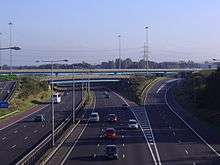
The Preston By-pass, opened 5 December 1958, became the first stretch of motorway in the UK and is now part of the M6 with a short section now forming part of the M55. It was built to ease traffic congestion caused by tourists travelling to the popular destinations of Blackpool and The Lake District. The first traffic cones were used during its construction, replacing red lantern paraffin burners.
In the 1980s, a motorway around the west of the city which would have been an extension of the M65 to the M55 was started but never finished. That is the reason that the M55 has no junction 2, because it was reserved for the new western bypass. The M6 between junctions 30 and 32 was widened extensively between 1993–95 to compensate. Junction 31A which has only a northbound exit and a southbound entry opened in 1997 to serve a nearby business park.
Other motorways terminating close to the city are the M61 – Preston to Manchester via Chorley and Bolton, the M65 – Preston to Colne via Blackburn, Accrington and Burnley and the M55 – Preston to Blackpool via Kirkham.
Rail
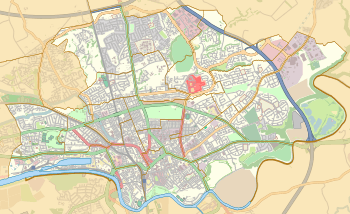
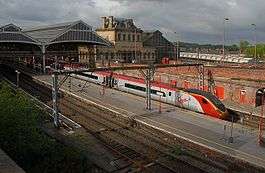
Preston railway station opened in 1838 and has since been rebuilt and extended several times. It is a major stop on the West Coast Main Line, with long-distance train services to London (Euston) in the south and Glasgow and Edinburgh, Aberdeen, Inverness and Fort William to the north. Preston is the hub for connecting rail services in the North West, with direct services to Blackpool, Lancaster, Blackburn, Bradford, Leeds, Wigan, Bolton, Manchester, Liverpool and Ormskirk.
The lines to Southport and Longridge closed to passengers in 1965 and 1930 respectively. The disused tracks of the Longridge line are extant as far as Deepdale. In 2010 plans were put forward to use part of this line for a demonstration tram system.[95] The heritage Ribble Steam Railway is located in Riversway.
Water
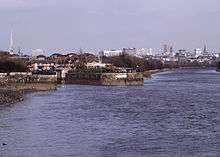
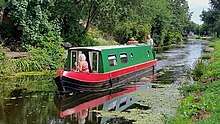
The former Port of Preston, known as Riversway or Preston Dock, has been the site of an expanding commercial and residential complex since 1988.
The Marina is just north of the River Ribble which enters into the east of the Irish Sea. This marina has its own chandlery and coffee shop, training courses and boat sales.
The Lancaster Canal runs from Preston to Kendal in Cumbria, providing 42 miles of navigable waterways. There are facilities for mooring narrowboats at its terminus at Ashton-on-Ribble.
There are multi-million pound plans to redevelop Preston's docks (as well as large sections of the River Ribble running through the city) to introduce leisure facilities (watersports), new landmark buildings, a new central park opposite Avenham Park, office and retail space, new residential developments and the re-opening of some of Preston's old canal. However, these plans, collectively known as Riverworks, have yet to undergo public consultation, and have already raised concerns amongst locals due to the potential loss of green space and increased risk of flooding.[96]
Bus
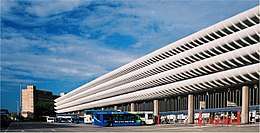
Five main bus operators serve Preston. Preston Bus, formerly the city's municipal bus company, served the district and operated a route between Preston and Penwortham. In October 2006, Preston Bus started operating two orbital bus routes.[97]
Many services between Preston and the surrounding area were operated by Ribble Motor Services which became part of the Stagecoach Group, using the name Stagecoach in Lancashire. Several of its routes were branded "Preston Citi"; they operated to Fulwood, Ribbleton, Penwortham, Longton, Walton-le-dale, Walmer Bridge, New Longton, Bamber Bridge, Longridge, Southport and Leyland. Stagecoach provided links to Blackpool, Blackburn, Bolton, Chorley, Liverpool, Manchester and Wigan as well as Lancaster and Morecambe under the Stagecoach in Lancaster service.
Competition for routes and passengers resulted in a bus war between the two companies after buses were deregulated in Great Britain.
On 23 January 2009, Preston Bus was sold to Stagecoach[98] for over £10.4 million. Routes were changed and the services were branded Stagecoach in Preston. Following a lengthy investigation which began soon after the takeover, the Competition Commission ruled on 11 November 2009 that the action by Stagecoach had adversely affected competition in the area and ordered it to sell Preston Bus. In January 2011, the Rotala Group announced they had agreed to take over Preston Bus.[98]
Blackburn Bus Company, part of the Transdev group, operates the 152 Hotline route to Blackburn and Burnley. An independent company, John Fishwick & Sons, that provided frequent services into the city centre for Lower Penwortham, Lostock Hall, Leyland, Euxton and Chorley, ceased trading in October 2015.
Preston also has a park and ride from two sites; one at Portway in the Riversway area, and the other off the A6 at Walton-le-Dale.
Preston is served by national bus services. Stagecoach, National Express, Eurolines, and Megabus have a presence at Preston bus station which is claimed by some residents to be the largest or second largest station in Europe.[99]
Preston was one of the first cities in the UK to have displays fitted to every bus stop which aim to provide an accurate time and destination of the next bus arriving using GPS tracking.[100] The service, initially restricted to services within the borough, was expanded to cover Fishwick's 111 City Centre/Leyland route but was discontinued in 2011,[101] and reinstated on some routes in 2013.
Air
Although not a public airport, Warton Aerodrome is an active airfield west of the city and is the airfield for the BAE Warton factory. BAE Samlesbury to the east of the town was an active aerodrome, with a gliding club, but today serves as a facility for BAE Systems and no longer supports flying activities.
The nearest airports from Preston with scheduled service are Liverpool John Lennon Airport and Manchester Airport, about 40 miles (64 km) south-west and south-east of the city respectively. Manchester Airport is linked by a direct rail service operated by TransPennine Express.
Walking and cycling
The Guild Wheel is a public footpath and cycle route, created in 2012 in celebration of the Preston Guild and officially opened in August of that year.[102] 21 miles (34 km) in length, it encircles Preston, linking the city to the countryside and surrounding villages.[103] Walking and cycling on the pathway along the banks of the Lancaster Canal is popular among the city's residents and visitors.
Education
The city is home to the University of Central Lancashire. Formerly known as The Harris Institute, Preston Polytechnic, and more recently (1985–1992) as Lancashire Polytechnic, "UCLan" is now the sixth largest university in the country, with over 33,000 students.[104]
Colleges of further and higher education
- Preston College – Mainly based in Fulwood with two campuses – one near the Royal Preston Hospital for A-Levels and vocational courses, and an arts college in Moor Park. Has COVE (Centre of Vocational Excellence) status in Retail.
- Cardinal Newman College – Based on a single campus in Avenham, close to the city centre. Specialises in A-Level qualifications.
- TUC Education Unit – Based at Buckingham House, Preston city centre
- Royal Preston Hospital – A teaching hospital, with a proportion of medical students from the University of Manchester based here for their clinical training.
High schools
- Archbishop Temple School
- Ashton Community Science College
- Abrar Academy
- Christ the King Catholic High School
- Corpus Christi Catholic High School
- Fulwood Academy
- Moor Park High School
- Our Lady's Catholic High School
- Preston Muslim Girls High School
- Sir Tom Finney Community High School
Public Health
Preston has a number of public and private hospitals, including:
- Fulwood Hall Hospital, a private hospital in Fulwood operated by Ramsay Health Care UK, providing a wide range of services[105]
- Greater Lancashire Hospital, a private hospital in Ribbleton operated by Bespoke Health Care Ltd, providing a limited range of services[106]
- Royal Preston Hospital, a general and teaching public hospital at Fulwood
Media

Preston has a number of local radio stations:
- Pulse Radio – student radio for UCLAN
- Greatest Hits Lancashire – Preston and Blackpool, classic hits
- Rock FM – Preston and Blackpool, pop music
- Preston FM – Preston community radio station
- City Radio Preston – internet radio station (launched August 2008)
- Ramadan Radio – An FM radio that only operates during the Muslim Lunar month of Ramadan.
Other regional stations which include Preston within their coverage include:
- BBC Radio Lancashire – Lancashire wide news, talk and classic hits (Broadcast from Blackburn)
- Heart North West – across the North West, pop (Broadcast from Manchester)
- Smooth North West – across the North West, easy-listening (Broadcast from Manchester)
- Capital Manchester - across the North West, pop (Broadcast from Manchester)
The Lancashire Evening Post is based in Fulwood.
Blog Preston[107] is a hyperlocal news website which provides community news, views and information about the city.[108][109]
Television is provided by ITV Granada, the ITV franchise holder for the North West region, BBC North West, the regional BBC station for the North West region, and a local TV service for Blackpool and Preston, That's Lancashire, from studios at the Northern Lights Business Centre in the University of Central Lancashire's Media Factory building.
VisitPreston.com is a website that "showcases everything that Preston has to offer to all audiences", providing information on topics such as business investment, education, tourism, etc. It is provided by key local stakeholders including the Preston City Council, Lancashire County Council, University of Central Lancaster, Preston Business Improvement District, and The Chase creative consultants.[110]
Sport
Preston North End F.C.
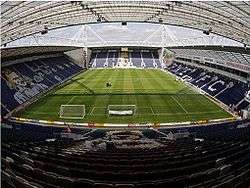
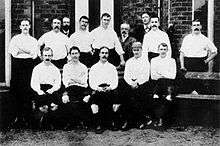
Preston North End F.C. were one of the founder members of the Football League and the first team to be crowned English football champions.[111] They play at Deepdale Football Ground which was also the original site of the National Football Museum. The museum closed in 2011 in preparation for its move to Manchester due to funding issues.
Dick, Kerr's Ladies, one of the most famous early women's football teams in Britain, called Preston home. Preston were champions of the Football League in its first two seasons, but have not won it since. Their last major trophy came in 1938 when they won the FA Cup, and they have not played top division football since 1961. They are one of the few English league clubs to have been champions of all four tiers of the English professional league.
UCLan Sports Arena
The UCLan Sports Arena is the University of Central Lancashire's multi-million pound sporting venue, catering for a wide range of outdoor sports such as football, rugby, athletics, hockey, tennis, netball and cycling on a 64-acre site. Open to students and the wider community, the arena is the city's premier multi-sports venue.[112]
The arena is located in Lea, approximately two miles from the university's main campus in Preston. A shuttle bus operates for students on Monday-Saturdays from outside the UCLAN Students' Union building in Fylde Road. As well as being the home of a number of university sporting clubs, the arena also hosts various public sporting clubs including the Preston Harriers Athletics Club and the Preston Springsfields Tennis Club.[113]
The arena has a 1.5km cycle track and a 0.75km junior cycle track, open for use by individuals, clubs and cycle races/meetings. It is often used for cycle racing by the university's cycling club, as well as local and regional events and at such times is closed to general users.[114]
Golf
Preston has a number of golf clubs with 18-hole courses, including:
- Ashton and Lea Golf Club[115], located in Lea to the west of Preston
- Longridge Golf Club[116], located in Longridge to the northeast of Preston
- Penwortham Golf Club[117], located in Penwortham on the southwest bank of the River Ribble
- Preston Golf Club[118], located in Fulwood to the north of Preston
Most clubs operate on a membership basis, and usually allow playing and non-playing visitors. Some also provide driving bays or ranges, and may provide further facilities such as restaurants and pro shops.
The Ingol Village Golf Club operated in Ingol in Preston's northwest from 1981 until its closure in 2017, when it was deemed nonviable due to dwindling membership.[119]
Other sports
Speedway racing, then known as Dirt Track Racing was staged at Farringdon Park in the late 1920s and early 1930s. The Preston team raced in the English Dirt Track League of 1929 and the Northern League of 1930 and 1931. The best known rider of the team was Joe "Iron Man" Abbott who went on to Test Match successes riding before the war for Belle Vue. After the war Joe appeared for Harringay and Bradford.
Preston is also the home of Lancashire's first roller derby league. The local team, Preston Roller Girls, have been playing since 2011.
Preston Grasshoppers RFC play in the National Division Two North, the third tier of English rugby union.
Preston Hockey Club was established in 1903.
The Preston Mountaineering Club is based in the town and has been in existence for over 70 years.
There is a ten-pin bowling centre at Greenbank Street.[120]
Attractions
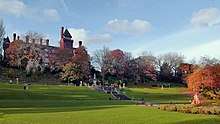


Popular attractions around Preston include:
- Avenham and Miller Parks: located a short walk from the centre of the city on the banks of the River Ribble, these large parks rank amongst the finest examples of traditional Victorian parkland in the North West of England.[121]
- British Commercial Vehicle Museum located in the nearby town of Leyland, approximately six miles (10 km) south of the city, the museum displays antiquarian buses, early fire engines and other historical and commercial vehicles produced by the British manufacturing industry.
- Harris Museum, Art Gallery & Preston Free Public Library: located in the city centre, the museum has collections on archaeology and local history; also fine art including decorative art, costume, and textiles, with a focus on local works.
- Lancashire Infantry Museum: located at Fulwood Barracks, the museum claims to be the "largest Regimental archive and the premier centre for military historical research in the North of England."[122]
- Lancaster Canal: from its terminus and boat basin at Ashton-on-Ribble the canal provides narrowboat cruising and a scenic cycle path and walk (approximately 22 miles) to Lancaster and destinations north.
- Museum of Lancashire: located a short walk from Preston bus station, the museum hosts historical collections on the theme of "Lancashire Through Time". On 30 September 2016 the museum closed to the general public due to council budget cuts. In July 2019 the council stated it was their "ultimate ambition" for the museum to reopen.[123]
- Preston Market Hall and Box Market: located on the site of the historic Covered Market and Fishmarket, traders sell local fresh produce, hot and cold foods to dine-in or take-away, artesan beer and coffee, gifts and bric-à-brac. Open Monday-Saturday.[74]
- Preston Minster, a grade II* building, dating from at least 1094, although most of it was rebuilt in the nineteenth century; it is the parish church of Preston.
- Ribble Steam Railway: a preserved railway running along Preston Dock, the museum includes workshops (where preservation work is undertaken), a visitor centre and cafe, and offers rides on restored steam trains on operating weekends.
- St Walburge's Church: located about a 15-20 minute walk from Preston Railway Station,[124] free guided tours are available around midday on Saturdays.[125] At certain times of the year, tours of the spire (the tallest in England for a church that is not a cathedral[58]) are available; tickets are limited and are available from the church in return for a recommended donation.[126]
Notable people
- Richard Arkwright was born in Preston and developed his water frame in the building now known as Arkwright House[127]
- Stu Bennett, WWE wrestler, lived in Preston until the age of six
- Holly Bradshaw, track and field athlete
- Clarke Carlisle, footballer and TV personality, born and brought up in Preston
- Josh Charnley, Warrington Wolves rugby league player and England international, born in Preston
- Helen Clitheroe, athlete
- Joseph Delaney, author of science fiction and fantasy books, born in Preston
- Tupele Dorgu, actress famous for her role as Kelly Crabtree in the British ITV soap-opera Coronation Street, born in Preston
- Anulka Dziubinska, model and actress who was the Playboy centrefold in May 1973, born and raised in Preston
- Tim Farron MP, Member of Parliament for Westmorland and Lonsdale and Leader of the Liberal Democrats
- Sir Tom Finney, footballer, played for Preston North End and England, born in Preston
- Andrew Flintoff, England and Lancashire cricketer as well as a current broadcaster, born in Preston. Granted freedom of the city following England's Ashes victory of 2005.
- Benjamin Franklin, one of the Founding Fathers of the United States, lived briefly on Friargate before returning to America; a Blue Plaque on the wall of the building commemorates the location[128]
- Lieutenant-General Sir John Bagot Glubb, better known as Glubb Pasha, born in Preston in 1897
- Nigel Greenwood, footballer who played for Preston North End
- Edmund Robert Harris, local solicitor and former Prothonotary for Lancashire, born and died in Preston. Harris was the principal benefactor of the Harris Museum, Harris Institute or Art School, Harris Technical School and the Harris Orphanage.
- A. J. Hartley, award-winning, bestselling novelist
- Lubaina Himid, Turner Prize-winning artist
- Susan Hanson, actress, famous for her role as Diane Hunter (aka 'Miss Diane') in the ITV soap opera Crossroads, which she played from 1965 until 1987, was born in Preston.
- Mary Anne Hobbs, English BBC Radio One DJ and music journalist, was born in Preston
- John Inman, actor famous for his role as Mr. Humphries in Are You Being Served?, was born in Preston
- Phil Jones, Manchester United footballer, was born in Preston. He attended Balshaw's CE High School in Leyland
- Anne Jessopp, first ever female CEO of the Royal Mint was born in Preston. Attended Kirkham Grammar School
- Stacey Kemp, (former competitive pair skater born 1988)
- Sarah Ann Kennedy, voice of Miss Rabbit in Peppa Pig and Nanny Plum in Ben and Holly's Little Kingdom, works at the University of Central Lancashire in Preston as a lecturer in animation[129]
- Simon Kerrigan, cricketer
- Ian Kirkham, saxophone player for the group Simply Red, born in Preston
- Mark Lawrenson, TV presenter, footballer and pundit was born in Penwortham, just south of the city centre and attended the former Preston Catholic College
- Thomas Lawson, football player
- John Boyle O'Reilly, Irish writer, journalist and civil rights activist lived in Preston from 1859–63, with his uncle and aunt. He worked at the Preston Guardian while living there.[130]
- Nick Park, animator and creator of Wallace and Gromit was born in Preston. In September 2007, Preston City Council announced that it would be raising £100,000 to build a bronze statue of the two characters[131]
- Robert W. Service, poet and writer associated with the Yukon Gold Rush, was born in Preston and lived for a time on Winckley Street in the city centre. There is a Blue Plaque commemorating him on Christian Road, near the railway station[132]
- Ranvir Singh, TV presenter and newsreader, born in Preston
- Francis Thompson, Victorian poet and ascetic, born in Winckley Street and has a memorial plaque there[133]
- Steve Walsh, Leicester City footballer, hails from the Preston suburb of Fulwood
References
- "'Proud Preston' wins city status", BBC News, 14 March 2002. Retrieved 6 June 2006.
- City of Preston: 132,000.Preston (Local Authority): Key Figures for People and Society: Population and Migration Archived 3 March 2016 at the Wayback Machine, Office for National Statistics. Retrieved 21 August 2010.
The population for the unparished area is calculated by subtracting the populations of the three rural Middle Layer Super Output Areas, Preston 001 (5,185), Preston 002 (6,417) and Preston 010 (6,134). Preston 001 (Middle Layer Super Output Area): Key Figures for People and Society: Population and Migration, Office for National Statistics. Retrieved 21 August 2010.
Preston 002 (Middle Layer Super Output Area): Key Figures for People and Society: Population and Migration, Office for National Statistics. Retrieved 21 August 2010.
Preston 010 (Middle Layer Super Output Area): Key Figures for People and Society: Population and Migration, Office for National Statistics. Retrieved 21 August 2010. - "2011 Census - Built-up areas". ONS. Retrieved 15 August 2013.
- "Lancashire - UK Census Data 2011". UK Census Data. Retrieved 8 November 2015.
- "The parish of Preston', A History of the County of Lancaster". A History of the County of Lancaster. 7: 72–91. 1912. Retrieved 13 March 2009.
- Hunt, 1992. p. 9.
- Hunt, 1992. p. 10.
- "History of English Place-Names". Heraldry.sca.org. 1 October 2005. Retrieved 17 July 2010.
- Hunt, 2003. p. 31.
- William Dobson, Rambles by the Ribble, Volume 3, "Ch. 8, Walton-le-Dale", Publisher: W. and J. Dobson, 1864
- Charles Hardwick, "On the Roman Remains Recently Discovered at Walton-le-Dale, Near Preston", in Transactions, Volumes 7–8, Historic Society of Lancashire and Published 1855, pp. 127
- Hodge, 1997. pp. 3–5.
- Walsh and Butler, 1992.
- Hodge, 1997. pp. 6–10.
- "What is Preston Guild?" at prestonguild2012.com
- Preston Guild - Friendship scrolls return Retrieved 3 September 2012.
- John Moss, for Papillon (Manchester UK) Limited. "The County of Lancashire, England, UK". Manchester2002-uk.com. Retrieved 17 July 2010.
- SP 36/75, fol.84, fols.177a, 179, Alexander Blair to Mrs Blair, 5 December.1745.
- [SP 36/75, fol.87, – to Lady Gask, 27 November.1745].
- Fitzroy Maclean, 'Bonnie Prince Charlie' 1988
- "Preston and Wigan Railway". www.railscot.co.uk. RailScot website. Retrieved 16 November 2017.
- "Preston Dock – Shipbreakers". ribblesteam.wordpress.com. The Ribble Pilot. 12 October 2013. Retrieved 16 November 2017.
- "Karl Marx in the New York Daily Tribune 1854". 1 August 1854. Retrieved 20 September 2006.
- Marsh, Arthur; Ryan, Victoria; Smethurst, John B. (1994). Historical Directory of Trade Unions. 4. Farnham: Ashgate. pp. 113–115. ISBN 9780859679008.
- "The Livesey Collection". Archived from the original on 11 September 2006. Retrieved 20 September 2006.
- Lambert, Tim, A Brief history of Preston, Lancashire
- "Live Preston Passion". BBC News. 6 April 2012.
- "Opening of the new Town-Hall at Preston". The Times. 15 September 1882.
- "August 1990 Maximum". Retrieved 26 February 2011.
- "1971–00 Annual average maximum". Retrieved 26 February 2011.
- "Max >25c days". Retrieved 26 February 2011.
- "Hot weather breaks record". Lancashire Evening Post. Preston. 4 October 2011. Retrieved 26 April 2012.
- "February 1969 minimum". Retrieved 26 February 2011.
- "1971–00 Average coldest night". Retrieved 26 February 2011.
- "1971–00 average frost". Retrieved 26 February 2011.
- Rogers, Simon (21 December 2010). "20 December 2010 minimum". The Guardian. London. Retrieved 26 February 2011.
- "1971–2000 Rainfall". Retrieved 26 February 2011.
- "1971–00 Wetdays". Retrieved 26 February 2011.
- Ed Walker (17 October 2014). "Preston is officially the third WETTEST city or town in Britain". BlogPreston. Retrieved 10 February 2020.
- Ed Walker (21 October 2014). "Preston is officially England's GLOOMIEST city". BlogPreston. Retrieved 10 February 2020.
- "Preston loses its soggy city status to Lancashire neighbour". Lancashire Evening Post. 23 March 2018. Retrieved 15 February 2020.
- "Climate Normals 1971–2000". KNMI. Retrieved 26 February 2011.
- http://www.rcdow.org.uk/fileupload/upload/PrestonGuildMass39201234132.pdf
- "Civic crest". preston.gov.uk. Preston City Council.
- "GENUKI: Preston, Lancashire genealogy". genuki.org.uk.
- http://www.lancsquakers.org.uk/preston.php
- "Pope creates new eparchy in Preston for Syro-Malabar Catholics". Catholic Herald.
- "Pope turns ex-Preston church into Indian Catholic cathedral". BBC.
- "Carey Baptist Church, Pole Street, Preston 1940". flickr.com/. 11 February 2010. Retrieved 13 July 2013.
- "GENUKI: St George the Martyr Church of England, Preston, Lancashire genealogy". genuki.org.uk.
- "St John XXIII Parish Preston". englishmartyrspreston.org.uk. Archived from the original on 2 May 2013.
- "Media Newsroom". The Church of Jesus Christ of Latter-Day Saints. 2007. Archived from the original on 14 May 2007. Retrieved 22 May 2007.
- Mormons reveal secrets of the temple. www.telegraph.co.uk. Retrieved 4 June 2008.
- Census 2001: Statistics.. Retrieved 6 June 2006.
- "Preston Synagogue & Jewish Community: Preston, Lancashire". JCR-UK. 19 February 2013. Retrieved 2 March 2013.
- "Prestonian". The Free Dictionary.
- m.moville. "The Prestonian | Preston City Council". www.preston.gov.uk. Retrieved 29 December 2016.
- "Guide to Preston". Retrieved 24 August 2007.
- "Preston bus station on UK monument 'at risk' list". BBC News. 5 October 2011. Retrieved 5 October 2011.
- "British Brutalism-World Monuments Fund". Retrieved 5 October 2011.
- Listed Buildings in Preston, Lancashire, England, retrieved 26 September 2013
- "Tulketh Mill". Engineering Timelines. Retrieved 28 April 2012.
- Preston City Centre Statue Trail (PDF). VisitPreston. p. 3. Retrieved 10 February 2010.
- Preston City Centre Statue Trail (PDF). VisitPreston. p. 2. Retrieved 10 February 2010.
- Preston City Centre Statue Trail (PDF). VisitPreston. p. 1. Retrieved 10 February 2010.
- "Preston City Centre Statue Trail". VisitPreston. Retrieved 10 February 2010.
- "Rail firm Alstom to close historic Preston site after 120 years". BBC News. 25 October 2017. Retrieved 10 February 2020.
- Coates, David (25 March 2009). "Goss in talks to axe 60 more staff". Lancashire Evening Post. Johnston Press. Retrieved 5 April 2009.
- "Lancashire County Council, Unemployment core data, official unemployment and claimant count". Lancashire County Council.
- Richard Partington (1 November 2018). "Preston named as most improved city in UK". Microsoft News. Retrieved 15 February 2020.
- "Confirmation of Relocation" (PDF). Retrieved 25 April 2007.
- "Contact LFE". League Football Education. 2009. Retrieved 13 December 2011.
- "Riversway Developments".
- "Preston Markets". VisitPreston. Retrieved 10 February 2020.
- "Our Business". KFC Development. Kentucky Fried Chicken. 2008. Retrieved 13 December 2011.
- "Capital Centre Walton-le-Dale". Retrieved 10 February 2020.
- "Deepdale Shopping Park". Retrieved 10 February 2020.
- "List of shops in Preston (PR2)". The Shops. Retrieved 10 February 2020.
- "Capital Centre Walton-le-Dale". Retrieved 10 February 2020.
- "Report Highlight's UCLan'S Importance To Regional Economy". University of Central Lancashire. Retrieved 10 February 2020.
- "Campus Masterplan 2020". University of Central Lancshire. Retrieved 10 February 2020.
- "Campus Masterplan 2020 - Our Vision". University of Central Lancashire. Retrieved 10 February 2020.
- "About Us". University of Central Lancashire. Retrieved 10 February 2020.
- "University's flagship project will complete in 2020". University of Central Lancashire. 27 August 2019. Retrieved 12 February 2020.
- "Campus Masterplan 2020 - Highways". University of Central Lancashire. Retrieved 10 February 2020.
- "UCLan Listed In Top 3.3% Of Universities Worldwide". University of Central Lancashire. Retrieved 10 February 2020.
- "How global university rankings are changing higher education". The Economist. 19 May 2019. Retrieved 10 February 2020.
- "£800 million plan could cause more traffic chaos". Retrieved 22 February 2008.
- "Tithebarn Project Hit by Grosvenor Withdrawal". Retrieved 9 April 2010.
- "Soaring Cost of Replacing Bus Station". Retrieved 14 May 2010.
- "John Lewis pull out of Preston revamp". Lancashire Evening Post. Preston. 17 November 2011. Retrieved 26 April 2012.
- "Top developer is still in the frame - VIDEO". lep.co.uk.
- "In 2011 Preston hit rock bottom. Then it took back control". The Guardian. 31 January 2018. Retrieved 8 January 2019.
- "Preston: City Of Ghosts". 6 April 2010. Archived from the original on 9 April 2010. Retrieved 26 February 2012.
- (26 March 2010), "Tram system demo could be in place soon", Lancashire Evening Post, Preston. Retrieved 4 August 2011
- "Flood plain housing plan slammed". Lancashire Evening Post, 30 June 2007. Retrieved 1 July 2007.
- Competition Commission (2009). Stagecoach Group Plc/Preston Bus Limited: A Report on the Completed Acquisition by Stagecoach Group Plc of Preston Bus Limited. The Stationery Office. p. 145. ISBN 978-0-11-706375-4. Retrieved 29 April 2012.
- "The History of Public Transport in Preston". Preston Bus. Retrieved 25 April 2012.
- "Second-best city". Lancashire Evening Post. Retrieved 7 July 2010.
- "Real Time Bus Information for Lancashire". Ormskirk Online News. 27 March 2003.
- Lancashire | Campaign for Better Transport. Bettertransport.org.uk. Retrieved on 17 July 2013.
- "Guild Wheel - Welcome". lancashire.gov.uk.
- Baines, Becky. "Miss". Lancashire County Counvil. Retrieved 22 May 2014.
- "Pocket Facts" (PDF). (708 KB), University of Central Lancashire. Retrieved 6 June 2006.
- "Fulwood Hall Hospital". Retrieved 10 February 2020.
- "Greater Lancashire Hospital". Retrieved 10 February 2020.
- http://www.blogpreston.co.uk
- McAthy, Rachel (17 February 2011). "Preston hyperlocal site wins funding for community project". Journalism.co.uk. Mousetrap Media Ltd. Retrieved 12 December 2011.
- "Story shorts – 21/02/11". Lancashire Evening Post. 21 February 2011. Retrieved 12 December 2011.
NESTA (National Endowment for Science, Technology and the Arts) has worked alongside the Big Lottery Fund to deliver support to 17 organisations nationwide. They include Prescap, Preston FM, Blog Preston and CSV Preston.
- "About Visit Preston". VisitPreston.com. Retrieved 15 February 2020.
- "Preston North End". Preston City Council. 11 December 2007. Archived from the original on 18 January 2008. Retrieved 29 November 2011.
- "UCLAN Sports Arema". University of Central Lancashire. Retrieved 10 February 2020.
- "UCLAN Sports Arema - Sports". University of Central Lancashire. Retrieved 10 February 2020.
- "UCLAN Sports Arema - Cycling". University of Central Lancashire. Retrieved 10 February 2020.
- "Ashton & Lea Golf Club".
- "Longridge Golf Club".
- "Penwortham Golf Club".
- "Preston Golf Club".
- "Ingol Village Golf Club, Preston". Golf's Missing Links. Retrieved 10 February 2020.
- "1stbowl.com".
- "Things To Do". Marketing Lancashire. Retrieved 10 February 2020.
- "Official site". Lancashire Infantry Museum. Retrieved 10 February 2020.
- Pail Faulkner (12 July 2019). "More money for the Lancashire museums which 'can't be closed'". Lancashire Evening Post. Retrieved 10 February 2020.
- "Directions to St Walburge's Church (walking)". Google Maps. Retrieved 10 February 2020.
- "St Walburge's Church Guided Tours". VisitPreston. Retrieved 10 February 2020.
- "St Walburge's spire tours extended by popular demand". BlogPreston. 13 January 2019. Retrieved 10 February 2020.
- Arkwright House, Preston, retrieved 27 September 2013
- "Benjamin Franklin blue plaque in Preston". Open Plaques. Retrieved 28 April 2012.
- "Sarah Ann Kennedy | Staff Profile |University of Central Lancashire". UCLan - University of Central Lancashire. Retrieved 20 February 2019.
- Birman, Wendy, "O'Reilly, John Boyle (1844–1890)", Australian Dictionary of Biography, National Centre of Biography, Australian National University, retrieved 17 August 2019
- "Wallace and Gromit statue planned for Preston". BBC News. 6 September 2007. Retrieved 12 June 2007.
- Robert William Service (1874–1958): Robert W. Service Blue Plaque, Preston. Robertwservice.blogspot.com. Retrieved on 17 July 2013.
- Good Stuff. "Francis Thompson bronze plaque in Preston". Blue Plaque Places. Retrieved 3 November 2015.
- PRESTON TWINNING retrieved 21 January 2019
- Lancashire Evening Post, Thursday 05 April 2018 retrieved 21 January 2019
- "British towns twinned with French towns". Archant Community Media Ltd. Retrieved 11 July 2013.
Bibliography
- Hodge, A. C. (1997) [1984]. History of Preston: An Introduction. Preston: Carnegie Publishing. ISBN 1-85936-049-1.
- Hunt, D. (1992). A History of Preston. Preston: Carnegie Publishing. ISBN 0-948789-67-0.
- Hunt, D. (2003). Preston: Centuries of Change. The Breedon Books Publishing Company. ISBN 1-85983-345-4.
- Sartin, S. (1988). The people and places of Historic Preston. Preston: Carnegie Publishing. ISBN 0-948789-25-5.
- Walsh, T. & Butler, G. (1992). The Old Lamb and Flag. Preston: Carnegie Publishing. ISBN 0-948789-79-4.
External links
![]()
